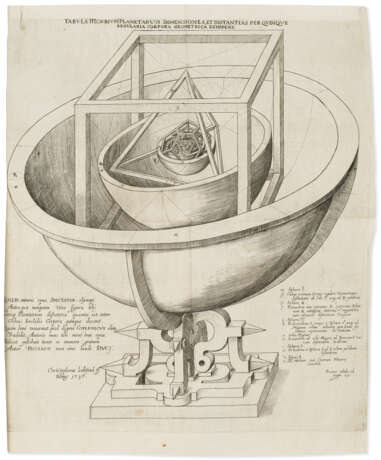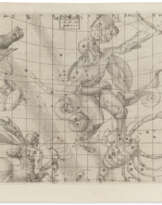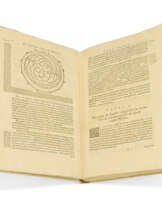ID 1360823
Lot 107 | Mysterium cosmographicum, and Apologia for Harmonices mundi
Estimate value
$ 18 000 – 25 000
Second edition, and the first edition of Kepler’s rebuttal to Robert Fludd. When first published in 1596 Mysterium Cosmographicum “was the first unabashedly Copernican treatise since De Revolutionibus itself ... Kepler argued that the sun’s centrality was essential, for the sun itself must provide the driving force to keep the planets in motion ... although the principal idea of the Mysterium Cosmographicum was erroneous, Kepler established himself as the first, and until Descartes the only, scientist to demand physical explanations for celestial phenomena. Seldom in history has so wrong a book been so seminal in directing the future course of science” (DSB). This second edition is greatly expanded with another two decades of Kepler’s thinking. The author’s notes and additions to this second edition are themselves almost half the length of the first edition text.
Robert Fludd and Kepler were at odds over this new, quantitative approach to nature, rather than Fludd’s symbolical and alchemical tradition. Kepler had referenced Fludd’s work in the appendix of Harmonices mundi and Fludd—irritated by Kepler’s brief and rather dismissive treatment—responded with a whole book, the Veritas Proscenium (1621). According to Caspar, Kepler promised his publisher in June of 1621 that he would reply to Fludd’s “silly book” and carried out his promise quickly that summer. Although Tampach released these two works together, Caspar considers them separate from each other and that the latter title is probably post-dated. The subject matter is wholly different. Houzeau and Lancaster 2841. Caspar 67-68.
Two parts in one volume, folio (311 x 190mm). Separate title-page for the Apologia. Illustrated with engraved folding plate; woodcut diagrams, including four folding plates (first three leaves including title quite frayed on outer edge, engraved plate with a marginal stub tear, pl. at p.55 with stub tear into image). 17th-century blind-ruled calf (spine and edges worn, pastedowns lacking, endpapers chipped). Provenance: Owen Gingerich (bookplate).
| Artist: | Johannes Kepler (1571 - 1630) |
|---|---|
| Place of origin: | Germany |
| Artist: | Johannes Kepler (1571 - 1630) |
|---|---|
| Place of origin: | Germany |
| Address of auction |
CHRISTIE'S 20 Rockefeller Plaza 10020 New York USA | ||||||||||||||
|---|---|---|---|---|---|---|---|---|---|---|---|---|---|---|---|
| Preview |
| ||||||||||||||
| Phone | +1 212 636 2000 | ||||||||||||||
| Fax | +1 212 636 4930 | ||||||||||||||
| Conditions of purchase | Conditions of purchase | ||||||||||||||
| Shipping |
Postal service Courier service pickup by yourself | ||||||||||||||
| Payment methods |
Wire Transfer | ||||||||||||||
| Business hours | Business hours
|











